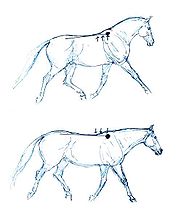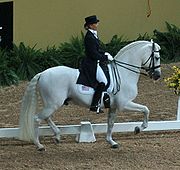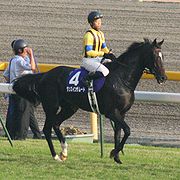.gif)
Collection (horse)
Encyclopedia

Horse
The horse is one of two extant subspecies of Equus ferus, or the wild horse. It is a single-hooved mammal belonging to the taxonomic family Equidae. The horse has evolved over the past 45 to 55 million years from a small multi-toed creature into the large, single-toed animal of today...
carries more weight on his hindlegs than his front legs. The horse draws the body in upon itself so that it becomes like a giant spring
Spring (device)
A spring is an elastic object used to store mechanical energy. Springs are usually made out of spring steel. Small springs can be wound from pre-hardened stock, while larger ones are made from annealed steel and hardened after fabrication...
whose stored energy
Energy
In physics, energy is an indirectly observed quantity. It is often understood as the ability a physical system has to do work on other physical systems...
can be reclaimed for fighting or running from a predator. The largest organic spring in the horse's body, and therefore the easiest one to observe in action, is composed of the spine and the associated musculature
Muscle
Muscle is a contractile tissue of animals and is derived from the mesodermal layer of embryonic germ cells. Muscle cells contain contractile filaments that move past each other and change the size of the cell. They are classified as skeletal, cardiac, or smooth muscles. Their function is to...
that draws it together in much the same way that a bow
Bow (weapon)
The bow and arrow is a projectile weapon system that predates recorded history and is common to most cultures.-Description:A bow is a flexible arc that shoots aerodynamic projectiles by means of elastic energy. Essentially, the bow is a form of spring powered by a string or cord...
is drawn by an archer
Archery
Archery is the art, practice, or skill of propelling arrows with the use of a bow, from Latin arcus. Archery has historically been used for hunting and combat; in modern times, however, its main use is that of a recreational activity...
.
Collection and the wild horse
Collection of the horse's body is an important mechanism for survival. If danger suddenly appears the horse has a large store of energy ready for instantaneous release and so it is much easier for it to spring away from the danger than if it had been caught flat-footed, or "on the forehandForehand (horse)
- Balance :A horse's "motor" is located in his hindquarters, and a horse that is heavy on the forehand is not able to properly move forward with impulsion...
."
When a strange horse comes upon the scene, when a horse catches the scent of a predator, or when a horse scents a potential mate, the attention of the horse is naturally aroused and its body prepares for action. It raises its head, arches its back, and in so doing brings its legs more under its body where they can maintain the bending of the spine by their contact with the earth. With each step forward this spring is released slightly and then immediately re-compressed.
Collection in riding


The most readily apparent form of collection can be observed when comparing different degrees of collection within a single gait. A more collected gait will have two main symptoms: the horse will lower his hindquarters and raise his forehand, and the horse will have more bend in the joints of his legs. Additionally, the stride length will be shortened. Collection may be performed at any gait.
However, this does not mean that any shortened gait is collected. Riders who try to pull their horses into a shortened gait (riding "front-to-back"), rather than contain the energy coming from the hindquarters (riding "back-to-front"), will produce a shortened stride, but the horse will continue to carry his weight on his front end, and will simply have stiff, unathletic movement. The shoulders will not be raised, and the horse will find it more difficult to perform a task than he would otherwise. The hind legs will usually be "strung out behind," rather than coming up under the body with each stride to support it, and the back will be dropped rather than properly raised upward.
Specific uses in sport
Collected gaits are asked for in dressage tests from the mid-levels upward, at the walk, trot, and canter. Additionally, a high degree of collection is required of the rider in more advanced dressage moves, such as the pirouettePirouette (dressage)
A Pirouette is a French word for the Ballet reference, "to whirl about."A pirouette is a two-track lateral movement asked of a horse in dressage, in which the animal makes a circle with its front end around a smaller circle made by the hind end...
, piaffe
Piaffe
The piaffe[p] is a dressage movement where the horse is in a highly collected and cadenced trot, in place or nearly in place. The center of gravity of the horse should be more towards the hind end, with the hindquarters slightly lowered and great bending of the joints in the hind legs...
, and passage
Passage (dressage)
The passage is a movement seen in upper-level dressage, in which the horse performs a highly elevated and extremely powerful trot. The horse is very collected and moves with great impulsion....
. The ultimate level of collection is the levade, in which the horse carries 100% of his weight on his hindquarters. Unlike a rearing
Rear (horse)
Rearing occurs when a horse or other equid "stands up" on its hind legs with the forelegs off the ground. Rearing may be linked to fright, aggression, excitement, disobedience, or pain. It is not uncommon to see stallions rearing in the wild when they fight, while striking at their opponent with...
horse, the horse's rear legs are well under it, and it can safely support itself in an upright position for a time and then lower itself to the ground under control.
Collection is also essential in jumping. Most horses will physically be unable to jump extremely high fences (such as those seen in Grand Prix show jumping
Show jumping
Show jumping, also known as "stadium jumping," "open jumping," or "jumpers," is a member of a family of English riding equestrian events that also includes dressage, eventing, hunters, and equitation. Jumping classes commonly are seen at horse shows throughout the world, including the Olympics...
or puissance
Puissance
Puissance is the high-jump competition in the equestrian sport of show jumping.The competition involves a maximum of five rounds - opening round followed by four jump-offs not against the clock. The first round consists of four to six large single obstacles including the puissance wall, the...
classes) without collection, as they will not have enough power to make it over the obstacle. Speed is not a substitute, and a horse that is simply galloped at a fence will find it extremely difficult to raise his forehand upward on takeoff and gain enough height over the fence. Instead, he will jump flat, without bascule
Bascule (horse)
Bascule is the natural round arc a horse's body takes as it goes over a jump. The horse should rise up through its back, stretching its neck forward and down, when it reaches the peak of his jump. Ideally, the withers are the highest point over the fence. This is often described as the horse...
, and will be much more likely to pull a rail. Secondly, horses must be adjustable within jumping courses, having the ability to shorten or lengthen their stride between obstacles, especially if placed in a combination. A horse that is not collected will find it very hard to seamlessly shorten his stride in a related distance, and may be forced to take off too close or too far away from the jump, which greatly increases the chance he will hit it.
Collection also makes it easier for a horse to make sudden changes of direction, such as those required by western performance horses. Cutting
Cutting (sport)
Cutting is an equestrian event in the western riding style where a horse and rider are judged on their ability to separate a single animal away from a cattle herd and keep it away for a short period of time.-Description:...
horses are excellent examples, as they crouch low and back on their hindquarters so they may quickly move side to side to mirror the movements of the calf.

